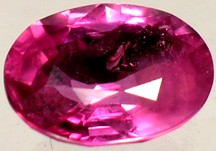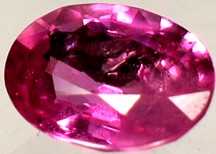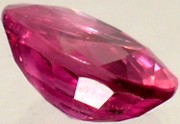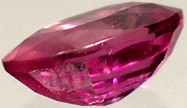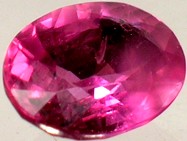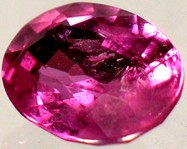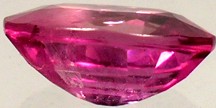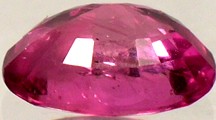|
For Customers outside of USA 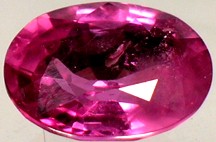
One Exquisitely Beautiful, Sparkling Antique Handcrafted Genuine Natural One and Three-Quarter Carat Oval Cut Vibrant Rose/Red/Pink Colored Sapphire Precious Gemstone. CLASSIFICATION : Faceted Neon Rose Hued Sapphire Oval. ORIGIN: The Ural Mountains, Russia. 19th Century. SIZE: Length: 8mm. Width: 6mm. Depth (Thickness): 4mm. All measurements approximate. WEIGHT: 1.71 carats. NOTES: Upon request we can set your gemstone as a ring, pendant, or as earrings.
DETAIL: A stunning, gorgeous, sparkling, vibrantly colored natural rose hued sapphire precious gemstone from the Ural Mountains of Russia. The gemstone is alive with flashes of red, bubble-gum pink, and even orange. The gemstone was hand crafted and faceted by a 19th century Russian artisan, part of an heritage renown for the production of the elaborate gemstones and jewelry of the Czars of Medieval, Renaissance, and Victorian Russia. The color is absolutely incredible, a sparkling, gorgeous and vibrant hue somewhere between rose and and rede. This incredible gemstone has all of the brilliance of a diamond, sparkling under any light source! It is really a phenomenal gemstone, guaranteed to make some extremely excited. The color is almost "neon", very bright, very intense, with flashes of neon rose-pink, red, and orange. This incredibly vibrant hue imparts exceptional character and great visual appeal. The shade of rose could perhaps be best likened those occasional roses which are in color a cross between pink, red, orange and rose. The gemstone looks ever so much like a sparkling, rose-hued diamond.
Good quality uncommonly hued ("fancy color") sapphires are in high demand, and can be quite costly. Unfortunately most seemingly flawless, transparent "sapphires" sold even by the largest and most reputable retailers in the United States are synthetic (read the fine print; and the same is true of emeralds and rubies). However the Southern Ural Mountains of Russia have been producing good quality, natural sapphires for centuries. This is obviously not a flawless specimen. Though the gemstone is absolutely transparent (not cloudy), there's a fairly sharp seam of colorless crystalline material, as well as one or two other little blemishes composed of the same material. Though the casual admirer is not likely to discern any blemishes with the cursory appreciative glance, close inspection, even with the naked eye, will reveal these blemishes. So the gemstone cannot really be honestly described as "eye clean", or even "near eye clean". However to the casual admirer it is certainly no worse than "slightly blemished". It is not uncommon for alexandrite to have colorless crystalline material within the gemstone, in the form of sprinkles, seams, or both, and it is quite clear examining these 500% photo enlargements that this gemstone possesses just such blemishes. Nonetheless, the gemstone still possesses wonderful color and wonderful fire (flashes and sparkles). Under magnification the gemstone shows the unmistakable characteristics of having been hand crafted. The coarseness of the 19th century finish is considered appealing to most gemstone collectors, and is not considered a detriment, or detract from the value of a gemstone. These characteristics are not only expected of hand-finished gemstones, most serious collectors consider such gemstones more desirable, possessed of greater character and uniqueness when compared to today's cookie-cutter mass-produced machine-faceted gemstones. Unlike today's computer controlled machine produced gemstones, the cut and finish of a gemstone such as this is the legacy of an artisan who lived two centuries ago.
This gemstone possesses superb color and sparkle, and to the eye is completely transparent, but it is not anywhere near flawless. True, the blemishes it possesses are not immediately discerned by the cursory glance of the casual admirer. However anything beyond a quick glance, any scrutiny will reveal the seam of colorless crystalline material. Magnified 500%, as it is here, you can easily pick out these blemishes quite plainly. Of course the same may said about almost any natural gemstone. An absolutely flawless gemstone simply is not the rule in nature. Most absolutely flawless gemstones will upon close examination be revealed to be synthetic. You might also notice under magnification occasional irregularities in the cut and finish. Naturally these characteristics are not only expected of hand-finished gemstones, you must also consider that two centuries ago the mining techniques prevalent did not allow the ultra deep mining operations which are so common today.
Keep in mind two centuries ago mankind was more or less limited to surface deposits or near surface deposits of gemstones. Higher quality gemstones which today are routinely mined from beneath hundreds of meters, even kilometers beneath the earth's surface, were simply inaccessible then. For these reasons antique gemstones must be appreciated as antiques first, gemstones second. The relatively superlative quality of contemporary gemstones routinely mined from deep beneath the earth's surface today were simply not accessible two centuries ago, or at least, only rarely so. However for most, the unique nature and character of antique gemstones such as this more than makes up for miniscule blemishes and cutting imperfections which by and large, are only visible under high magnification.
HISTORY: Sapphires have been since ancient times one of the most highly valued of all gemstones, and references to the gemstone date back to about 800 B.C. The name "sapphire" comes from the Latin "sapphirus" and the Greek "sappheiros", which translates to "blue" in both languages. The name sapphire is also a derivative of the ancient Hebrew and Persian word for "blue" as well. To the ancient Romans however, the word "sapphirus" actually referred to lapis lazuli, another blue gemstone. What the Romans called blue sapphire translates to "hyacinth"; the green sapphire was "emerald", and the purple sapphire was "amethyst". In the ancient Mediterranean world, priests and sorcerers honored the sapphire above all other gems. They believed that the sapphire enabled them to interpret oracles and foretell the future.
The ancient Persians believed that the earth rested on an enormous sapphire, and the sky reflected its beautiful color. They referred to the sapphire as "the gem of the heavens". As the centuries passed, European royalty came to favor sapphire believing the stone would provide protection from harm. Throughout Medieval Europe, the sapphire was thought to give the wearer strengthened vision, including visions of the future. Sapphire was regarded as an antidote to black magic and effects of evil spirits. It was held to be a symbol of truth and constancy. Sapphires are a member of the corundum family, and close relative to the ruby. In fact, a ruby is simply a red sapphire. The sapphire is considered one of the most valuable of precious stones. The principal sources of sapphire in modern history are Russia, Siam, Ceylon, Burma, Africa, and Australia.
SHIPPING OPTIONS: All purchases are backed by an unlimited guarantee of satisfaction and authenticity. If for any reason you are not entirely satisfied with your purchase, you may return it for a complete and immediate refund of your entire purchase price. Most of these antique gemstones were originally part of two collections, one originating in India principally composed of gemstones originally mined in India, Burma, Ceylon, and Siam, and then hand faceted in India. The addition of a second accumulation of antique gemstones originally mined in the Urals in the mid to late 19th century (including alexandrite) completed the collection. These gemstones as well were hand finished. The Urals have been one of the world's major sources of precious and semi-precious gemstones for many centuries. As well, additional specimens are occasionally acquired from other institutions and dealers in Eastern Europe and Asia. These antique gemstones are now in the United States and are available for immediate delivery. We ship inventory from the USA order fulfillment center near Seattle, Washington. Your purchase will ordinarily be shipping within 48 hours of payment. A certificate of authenticity is available upon request. We prefer your personal check or money order over any other form of payment - and we will ship immediately upon receipt of your check (no "holds"). We will accept PayPal payments. Please see our "ADDITIONAL TERMS OF SALE".
|
|---|
